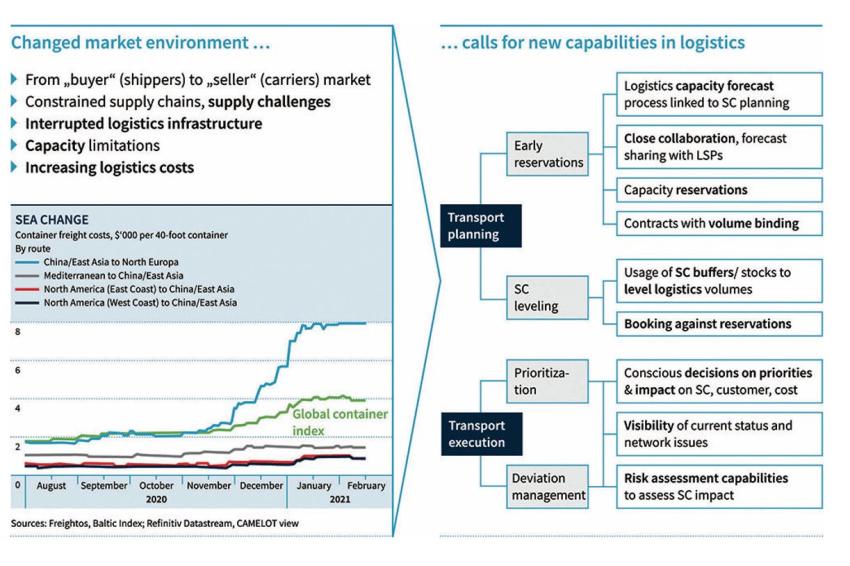Strategic Planning in Transport Management
From Production Planning to Strategic Transport Planning
The uncertain environment of the past few years has turned the logistics market into a seller market. Shippers can stay ahead of the game through tactical and strategic planning in transport management enabled by accurate logistics forecasts.
The recent global events have forced organizations to deal with never-before-seen unpredictability and complexity. At the same time, they have exposed the fragility of supply chains. A prime example is forwarding companies, which have been hit hard by the situation. The prevailing uncertainty resulted in empty containers and losses for carriers, which in turn led to supply chain bottlenecks and delivery problems around the world. Shippers have realized that they must adapt to the new global challenges and that a resilient supply chain is needed to satisfy increasing customer needs, meet strict lead times, and stay ahead of the competition.
„Due to the considerable capacity constraints of the recent past, the logistics market experienced a change from a “buyer” to a “seller” market.“
Logistics Challenges & Trends
Due to the considerable capacity constraints of the recent past, the logistics market experienced a change from a “buyer” to a “seller” market, which, in the logistics terminology, means a more dominant position of carriers over shippers. Capacity limitations associated with rising logistics costs pose an imminent risk to shippers’ delivery efficiency and are calling for new capabilities in transport logistics management.
Tactical and strategic planning in transport management is one of these new capabilities and a very promising one, in fact. It helps shippers overcome capacity limitations and leverage extensive logistics optimization potential. Integrating logistics forecasting into operations is an essential enabler for this capability.
Poor Logistics Forecasting
Shippers may experience a wide range of problems resulting from low-quality logistics predictions. These issues lead to higher costs and negatively impact operations and relationships with business partners. Inaccurate forecasting can make it difficult to properly manage assets and match transportation demand with the available capacity. Overbooking of transportation resources may lead to wasted capacity and additional costs, while underbooking may result in missed delivery dates and extra transportation costs. Aside from the financial consequences, poor forecasting may lead to unsatisfied customers and uneasy relationships with carriers. So how can you ensure that logistics forecasts will actually improve decision-making and competitiveness?
Doing it Right
Incorporating logistics forecasting into operations is the answer to resolving the challenges described above. While production planning is a well-known concept for companies, few have realized the potential of translating production demand figures into an outlook on transport logistics demand. A more accurate logistics forecast helps companies to communicate and secure transportation capacity at the carriers more efficiently. In addition, the forecasts can be incorporated into strategic tenders and used to supplement historical data.
The Benefits
Utilizing logistics forecasting in a company‘s operations and strategies can bring numerous benefits. Communicating capacity to the carriers regularly improves the logistics process of a company. This proactive approach allows carriers to plan and prepare for the company‘s future volume, ensuring they have the required resources in place, resulting in lower risk, lower costs, and greater efficiency from the company‘s perspective.
„Utilizing logistics forecasting in a company's operations and strategies can bring numerous benefits.”
Also, a reliable logistics forecast enables the reservation of the capacities at the forwarders, reducing the risk of booking too many or too few trucks or containers, which would result in high costs. This approach provides short-term savings for the company, by paying only for the capacity that will be needed. The benefits of working in closer collaboration with logistics partners go beyond the pure operational subcontracting and tendering relationship, it facilitates better plannability on the side of the logistics service provider and, ultimately, leads to a more secure capacity situation even in peaks. In addition to the benefits that come from regular proactive communication, a far-reaching planning horizon for logistics capacities as well as further advantages can be reached. The forward-looking approach, which results from integrating supply chain planning and logistics forecasting, breaks up silo thinking and helps logistics leave behind the firefighting mode and provide a strategic contribution to corporate success in the longer run. Reliable logistics forecasting based on Sales and Operations Planning allows identifying pro-actively optimization areas in terms of tactical decision-making. It helps to optimize and expand the mode-of-transport selection by adding new transportation lanes. In addition, the potential of cross-site shipment consolidation and optimized shipment frequencies can be maximized and the most cost and time-efficient transports organized, leading to optimized lead times and full containers.
Integrating supply chain planning and logistics forecasts does not just enable organizations to secure transportation capacity at the carriers and allow for pro-active optimization. It also offers a major advantage in strategic tendering. By supplementing historical data with forecast values, a more accurate picture of future shipments and the company’s business requirements emerges. From a long-term perspective, it leads to lower transportation costs, higher reliability and predictability, increased profitability, and optimal asset utilization.
Supply Chain Efficiency
Implementing effective logistics forecasting enables effective tactical and strategic planning, thus contributing to overall supply chain performance. Integrating advanced IT solutions specifically designed for logistics forecasting helps to increase forecast accuracy, reduce manual effort, and decrease overall process costs. These solutions provide improved visibility and end-to-end transparency within the supply chain, allowing for more informed decision-making regarding business partnerships and market focus. Incorporating the solutions into the decision-making process helps optimize freight spend and make more effective strategic transportation management decisions. Implementing the capability for tactical and strategic planning enables companies to build a smoother and more resilient supply chain and gain a clear competitive advantage.
Authors: Zsolt Simon, Head of Transport Management Competence Center and
Noémi Lucz, Consultant Transport Management, Camelot Management Consultants AG, Munich, Germany











